Scientists warn about the climate and ecological crisis on the planet, activists shout, and the media are intimidated.
Environmental problems, which threaten the lives of animals and plants and all humankind, affect, frighten, and disturb more and more.
But scientific data is sometimes too complex and abstract to understand, and activists’ warnings are too disturbing for ourselves.
And here, art comes to the rescue. It helps to see the invisible, touch the distant, understand the difficult, and share your fear, turning it into beautiful.
Let’s check the ten attempts by famous and not-so-famous artists to talk about the pain of our planet. They were collected with love by Oleksandra Khmarna, NGO “Ecoaction” activist, for “Ukrainska Pravda. Life”.
Wheatfield
Agnes Denes
Agnes Denes, an American of Hungarian descent, is one of the most prominent artists in environmental art.
And she did it quite literally. In 1982, she grew a wheat field at a Manhattan landfill in New York, a few blocks from Wall Street, the world’s economic center.
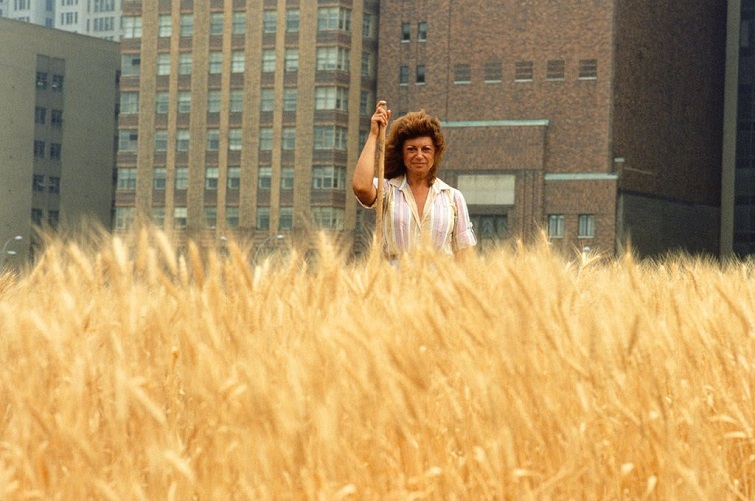
The artist grew a field of wheat in the Manhattan landfill.
Agnes did all the work herself, caring for a plot of 80 acres for months.
Choosing a place for environmental art can play an important role, as Agnes did.
A wheat field against the backdrop of famous skyscrapers creates a powerful paradox. It represents food, world trade, the economy and wealth, and is reminiscent of environmental problems and world hunger.
The field reminds us of how careless we are with nature and waste valuable resources.
As befits activist art, the Wheat Field has become not only a symbol but also an action. The grown grain traveled to 28 countries, where it was used to grow new crops.
Thus, the famous work of the artist not only drew attention to the problems but also helped to overcome them.
7000 Eichen“7000 oaks.”
Joseph Boyce
Another artist used plant planting as a creative and ecological manifesto.
In the 1980s, in the German city of Kassel, Josef Boyce planted 7,000 trees, each of which he installed a small basalt pillar. This material is used to make rubble, cobblestones, and cement – materials that systematically and massively displace the natural world, turning it into cities.
The action itself promoted the idea of the ”afforestation of cities instead of city management.”
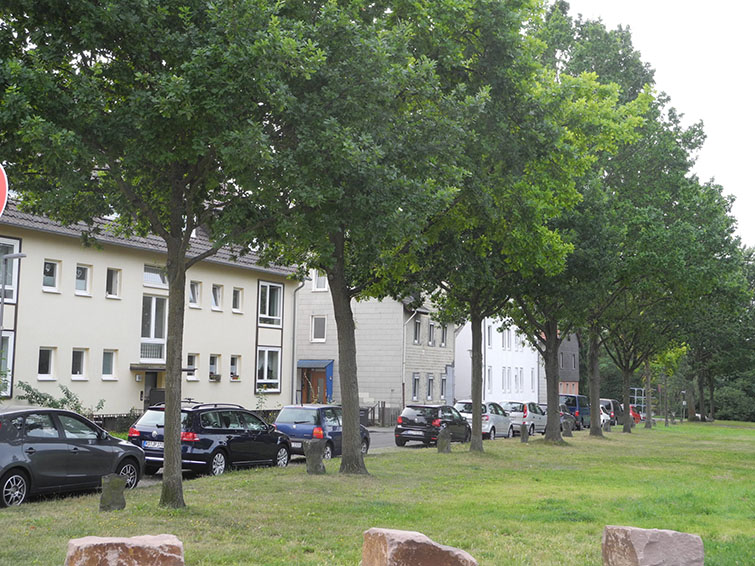
Near each of the 7,000 trees, the artist installed a small basalt pillar.
The oak was also chosen not by chance. From time immemorial, this tree has been a sacred symbol since the time of the Druids; it marked the holy places. Therefore, planting these trees meant a return to the roots, traditions, and nature.
The artist hoped that his action would become not just a tree planting but a symbolic beginning that should stimulate and provoke people worldwide to plant trees to overcome environmental and social change.
Although some criticize this work, considering basalt stones ugly, it also had its support.
In the 2000s, a Joseph Boyce Sculpture Park appeared in Baltimore, USA, and an entire community planted more than 350 trees in the city.
The Oldest Living Thing in the World
Rachel Sassman
Speaking of the original, it is a sin not to mention the large-scale project of American photographer Rachel Sassman.
Since 2004, she has traveled the world with biologists and photographed creatures that have lived continuously for more than 2,000 years.
Its collection includes Antarctic moss, which has existed for more than 5,500 years, and the only shrub of its kind that reproduces independently and has lived in Tasmania for 43,600 years.

Antarctic moss is the oldest living creature.
Although, according to the author herself, her work is more scientific, but it also carries a powerful environmental message.
The work shows the living history of the planet, the species that lived in the world before the Christian “beginning of time,” the species that lived in a changing world for millennia, many of them – in complex and changing conditions.
Two of them have already died at human hands. Therefore, these images also serve as a constant reminder of life on the planet, for which we are now responsible.
In 2014, Rachel published a book of the same name, where she collected the stories of her travels searching for unique living beings and the stories of scientists who study them.
Confluence (Our Changing Seаs V)
Courtney Mattison
Another active defender of not-so-noticeable creatures, Courtney Mattison, constantly raises the theme of the seas and their inhabitants in her work – hence the series of works “Our Changing Seas.”
Her work attempts to attract attention and encourage politicians to take active action to protect vulnerable beings who suffer because of our activities.
“Merger” depicts Indonesian coral reefs in pottery – this material represents the beauty and fragility of living things.
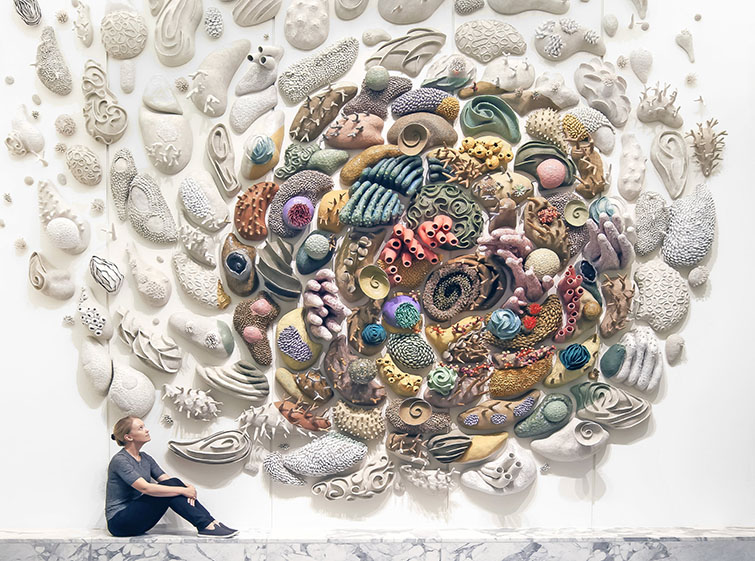
Courtney Mattison constantly raises the theme of the seas and their inhabitants in her work
Corals, anemones, sponges, and other inhabitants of reefs form a perfect natural spiral shape.
The further this spiral unwinds, the weaker and paler its characters become.
This is a story about how the ocean absorbs more and more carbon and becomes more acidic with climate change.
In such an environment, coral reefs – one of the richest ecosystems – are bleached and destroyed, leaving millions of other creatures homeless.
Like the climate crisis, the installation is developing in a spiral, with each turn of which the changes become worse and more irreversible.
According to scientists, if nothing is changed, we risk losing up to 99% of all coral reefs.
Bee the Change
(around the consonance of the English words “be” and “bee”)
Takashi Murakami and the Pangaia brand
Another project to protect those who cannot defend themselves from the threat of humanity is the Japanese artist Takashi Murakami.
He blurs the line between elite and mass art in his work, so his project is as accessible as possible to a broad audience.
Together with the brand of ecological clothes, Takashi launched a collection of T-shirts and skinny with the image of a bee and branded flowers, which have appeared many times in his previous works.
T-shirts are almost half made of recycled cotton; the rest is organic cotton. Its cultivation does not use chemicals, which often become the greatest threat to the lives of bees.
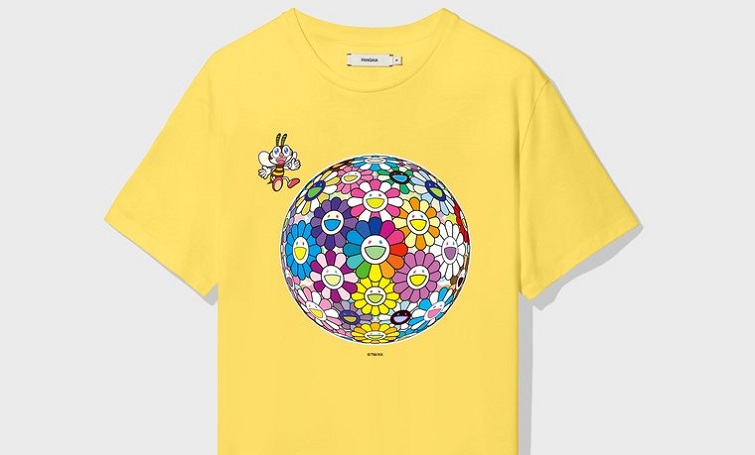
Takashi Murakami blurs the line between elite and mass art
The money from the sale of clothes is transferred to the fund of the same name, which supports projects for protecting and preserving bees. After all, it is from these little creatures that global food security largely depends – they fertilize more than two-thirds of crops.
And now, due to the worsening climate crisis and the spread of pesticides, they are closer to extinction than ever.
Warming Stripes
Ed Hawkins
This is a successful minimalist visualization of data, which does not prevent it from looking and, in some ways, being a work of art.
Ed Hawkins is a climatologist who tried to show climate change simply and clearly and created many graphics and animations, but it was the lanes that did their job best and became very popular.
This image even adorned the walls of famous buildings in Madrid in 2019, when the next climate conference of the world was held there.

Through art, the climatologist tried to show climate change simply and clearly
Each vertical bar indicates a year. Blue indicates those whose average annual temperature was lower than the average for the 20th century, and red indicates those with a higher temperature.
Thus, the naked eye can see that the changes we are witnessing now are not a coincidence but a sad pattern that has been going on for at least a century and a half.
And even allows us to imagine what a “black” future awaits us ahead.
Intolerable Beauty
Chris Jordan
The American photographer Chris Jordan talks about the “black” present in his works.
In a series of photographs entitled “Portraits of American Mass Consumption,” the author collects an impressive collection of discarded items: mobile phones, cars, cigarette butts, glass bottles.
Large-scale photographs of landfills of seemingly innocent items show how significant is the problem of small items multiplied by the number of people consuming them. You can see cell phone replaced with a newer model. And a pack of smoked cigarettes. And empty beer bottle. All this overtime and stretching across America becomes an environmental catastrophe if you do not learn to handle this garbage more responsibly.

The photographer documents mass consumption
The works of Chris Jordan make us think about whether we consume too much.
It will not be superfluous for a new thing if the “old” still performs all the functions we need.
Is the prestige that the new version of the new smartphone gives us, a planet that will suffer because of the discarded old one.
This is the best example of how effective our small decisions can be when we are not alone in our choices.
And they also give hope because if one lousy decision becomes a problem, then one good one can also become its solution.
One unpurchased thing can reduce the scale of Chris’s photos by just a little. But many unpurchased – and therefore not discarded – things can turn these pictures into an empty space.
Ice Watch
Olafur Eliasson
Danish sculptor of Icelandic origin Olafur Eliassonoften uses in his works natural phenomena – water, light, ice.
Perhaps it was his origin that prompted the sculptor to create an installation about another sad manifestation of the climate crisis – the melting of glaciers.
Ice blocks directly from Greenland near the British Tate Gallery are laid out in the shape of a clock. Gradually melting in the sun, they remind us that there is less and less time to save the planet from a climate catastrophe. And that the changes that human activity leads to can be irreversible.
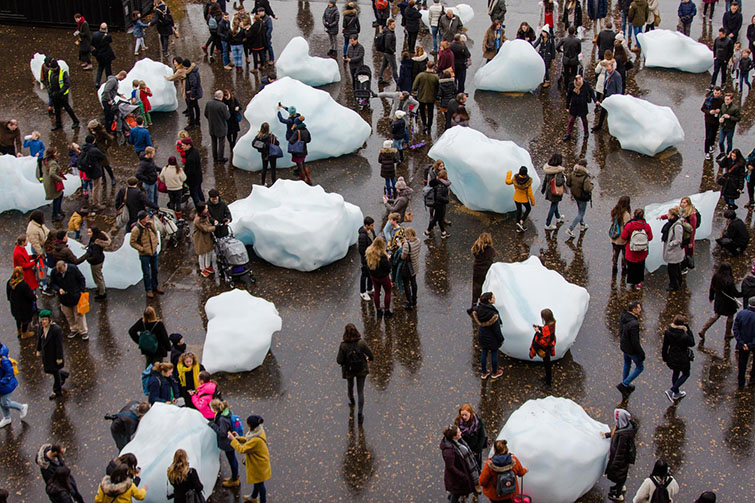
Ice from Greenland melted near the British Gallery
It’s also an excellent way to give residents of London the ability to touch what may soon disappear and feel this loss physically.
It is possible that the artist’s work has inspired climate activists, who in 2019 became more active in street strikes, and sometimes also used ice in their actions.
Ukraine also does not stand aside from the global movement, although our artistic concern for environmental issues spills over collective projects.
NGO “Ekoltava” (Poltava), NGO “ITTA” (Chernivtsi), and coordinator Iryna Zamuruyeva brought together 16 people: artists, scientists, and activists.
They broke up into creative tandems and shared knowledge, experience, views, and concerns about the climate crisis for eight days at the art residency.
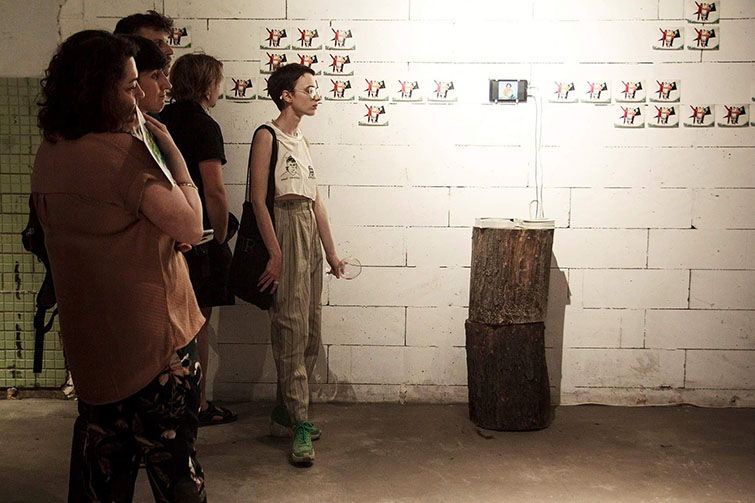
In Ukraine, artistic concern for environmental issues spills over into collective projects
The work of the teams resulted in joint projects that were presented at exhibitions in Kyiv and Chernivtsi. Their works raise the issues of deforestation, swamps, desertification, and the harmful effects of the coal industry on the environment.
During the exhibitions, the authors declared the State of Emergency Climate and presented a Declaration developed jointly with all participants of the project and climate organizations “Ekoltava” and “Ecoaction.”
It supports and reinforces the need to move to cleaner energy sources to overcome the climate crisis, open hydrometeorological data, and free access to civil society).
This unique project shows how science, art, and activism can help and reinforce each other.
Wrapped in Plastic
Plasticwood
Another Ukrainian collective project highlights another global problem through art – mass littering of the planet.
Activists turn garbage and waste into installations from the natural world: grass from toothbrushes, plants from disposable tableware, clouds from plastic bags.
And for the climate march in Kyiv in 2019, they brought their own dinosaur, created from unprocessed household waste, in which the planet is drowning.

Activists are turning garbage and waste into installations from the natural world
The group’s work was presented at the interactive exhibition Wrapped in Plastic, where they also introduced the first series of stop-motion cartoons about the Garbie doll (a play on words around the English “garbage”).
It is a tern that may soon become our reality about the environment, entirely captivated by the consequences of our excessive consumption, which fully displace nature.
The authors collect materials for their works on their own or receive them from organizations engaged in waste sorting.
This is an open volunteer project that continues to this day and continues to prepare installations. So everyone can help with their sorted garbage, hands, or creative ideas.
***
Not only can people from art, science, or public organizations become the voice of the silent, the protector of the weak, and create something beautiful out of their concerns for the environment.
It is unnecessary to plant wheat fields or transport Greenland ice to the Persian Gulf (or Europe). Find what you are strong at or what makes you happy, and let it become your tool to fight for the environment.



